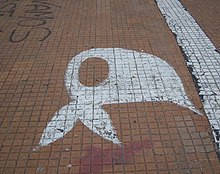User:FurciferRNB/Mothers of the Plaza de Mayo

The Mothers of the Plaza de Mayo (Spanish: Asociación Madres de Plaza de Mayo) is an association of Argentine mothers whose children "disappeared" under the military dictatorship of the 1970s.
Origins of the movement[edit]
The Mothers of the Plaza de Mayo is a unique organization of Argentine women who have become human rights activists in order to achieve a common goal. For nearly three decades, the Mothers have fought for the right to re-unite with their abducted children.
In protests, they wear white scarfs in remembrance of the diapers of their lost children. The name of the organizations comes from the Plaza de Mayo in central Buenos Aires, where the bereaved mothers and grandmothers first gathered. They gather every Thursday afternoon for a half hour walk around the plaza.
The Mothers' Association was formed by women who had met each other in the course of trying to find missing sons and daughters, abducted by agents of the Argentine government during the years known as the Dirty War (1976–1983), many of whom were then tortured and killed. The founder of the Association, Azucena Villaflor, along with 13 other women, started the demonstrations on the Plaza de Mayo, in front of the Casa Rosada presidential palace, on 30 April 1977. Villaflor had been searching for one of her sons and her daughter-in-law for six months. She was taken to the ESMA concentration camp on 10 December 1977.
The military have admitted that over 9,000 of those kidnapped are still unaccounted for, but the Mothers of the Plaza de Mayo say that the number is closer to 30,000. The numbers are hard to determine due to the secrecy surrounding the abductions. Three of the founders of the mothers of the Plaza de Mayo have also "disappeared". After the fall of the military regime, a civilian government commission put the number of disappeared at close to 11,000.
In January 2005 the body of French nun Leonie Duquet, Mothers of the Plaza de Mayo supporter, was exhumed, without an established identity. Duquet's dissapearance had caused international outrage towards the Argentine military government. DNA tests concluded, on August 30 of that year, that the body exhumed in January was that of Duquet.
Azucena Villaflor's remains, together with those of two other pioneer Mothers, Esther Careaga and María Eugenia Bianco, were also identified by a forensics team in mid-2005. Villaflor's ashes were buried at the foot of the May Pyramid in the Plaza on 8 December.
Divisions and radicalization[edit]
In later years, the association grew and became more persistent, demanding answers from the government as to where their missing children were. After the military gave up its authority to a civilian government in 1983, the Mothers of the Plaza de Mayo have pressed the new government to help find answers to the kidnappings that took place in the of the Dirty War years.
In 1986, the Mothers Association split into two factions. The Madres de Plaza de Mayo – Línea Fundadora (Founding Line) focuses on legislation to help in recovering remains and bringing ex-officials to justice.
In the course of their struggle, some of the Mothers of the Plaza de Mayo began to see themselves as inheritors of their children's dreams and responsible for carrying forward their children's work, even to the adopting the radical agenda embraced by some of their disappeared sons and daughters. As a result, the Asociación Madres de Plaza de Mayo faction led by Hebe de Bonafini takes a more political approach. This group does not doubt the fact that their children disappeared, and they are aware that the majority of them faced torture and most of them were ultimately murdered. Nevertheless, they are refusing any help offered by the government as compensation for their children's absence. Many still maintain that they will not recognize the deaths until the government admits its fault and its connection to the dirty war and its systematically forced disappearances.
A scholar of the movement, M. G. Bouvard, wrote that the Association faction wants "a complete transformation of Argentine political culture" and "envisions a socialist system free of the domination of special interests." The Mothers Association is backed by younger militants who openly support a Cuban-style revolution in Argentina. Bonafini has gone so far as to reject the universalist definition of human rights and defend the "anti-imperialist" actions of the September 11, 2001, airline hijackers.[1]
The Grandmothers[edit]
The Grandmothers of the Plaza de Mayo (Spanish: Asociación Civil Abuelas de Plaza de Mayo) is a related organization with similar origins. It was founded in 1977 to locate children kidnapped during the repression and return them to their biological families. The work of the Abuelas has led to the identification of over 10 percent of the estimated 500 children kidnapped or born in detention during the military era. Their work led to the creation of a National Genetic Data Bank.
On 10 December 2003, the Grandmothers' president, Estela Barnes de Carlotto, was awarded a UN Human Rights prize.
External links[edit]
- Asociación Madres de Plaza de Mayo (in Spanish)
- Madres de Plaza de Mayo – Línea Fundadora (in Spanish)
- Asociación Abuelas (in Spanish)
- Proyecto Desaparecidos (in Spanish)
References[edit]
- Mothers of the Disappeared, by Jo Fisher (1990).
- Revolutionizing Motherhood: The Mothers of the Plaza de Mayo, by Marguerite Guzman Bouvard (1994).
- Circle of Love Over Death: Testimonies of the Mothers of the Plaza de Mayo, by Matilde Mellibovsky, trans. by Maria & Matthew Proser (1997).
- Searching for Life: The Grandmothers of the Plaza De Mayo and the Disappeared Children of Argentina, by Rita Arditti (1999).
- Página/12, 9 December 2005. Las cenizas de Azucena, junto a la Pirámide (in Spanish).
